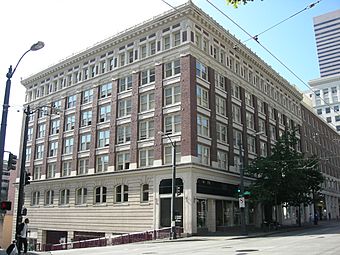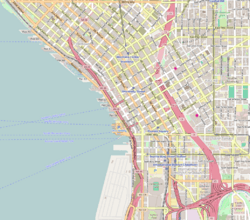Lyon Building facts for kids
|
Lyon Building
|
|

Viewed from the southeast in 2007
|
|
| Location | 607 Third Ave., Seattle, Washington |
|---|---|
| Area | less than one acre |
| Built | 1910 |
| Architect | Graham, John, Sr.; Meyers, David J. |
| Architectural style | Chicago school |
| NRHP reference No. | 95000806 |
Quick facts for kids Significant dates |
|
| Added to NRHP | June 30, 1995 |
The Lyon Building is a historic building in Downtown Seattle, Washington. It was built in 1910 by the Yukon Investment Company. The building was named after Lyon, France, honoring the French background of its owners.
It was designed by the firm of Graham & Myers in the Chicago school style. The Stone & Webster company built it. This company used non-union workers, which caused problems. An explosion happened at the unfinished building. Luckily, the strong building was not destroyed. It was finished in 1911.
The Lyon Building quickly became a popular place for lawyers and judges. This was because it was close to Seattle city offices and the King County Courthouse. Many foreign consuls and social clubs also started there. The City University of Seattle was founded in this building. Today, the basement is an entrance to the Pioneer Square station of the Seattle Transit Tunnel.
The Lyon Building was added to the National Register of Historic Places in 1995. It became a Seattle landmark in 1996. In 1997, it was changed to help people experiencing homelessness. The non-profit Downtown Emergency Service Center now owns and uses the building.
Contents
History of the Lyon Building
Before the Lyon Building was Built
The land where the Lyon Building stands was once the home of Bailey Gatzert. He was Seattle's 8th mayor from 1875 to 1876. Gatzert was also a leading businessman in the 1800s. His home was built in 1875 and was one of the fanciest houses in Seattle.
President Rutherford B. Hayes even visited the Gatzert home in 1880. In 1892, the Gatzerts bought new land to build a bigger house. But Bailey Gatzert passed away in 1893. His new property was later given to the Roman Catholic Archdiocese of Seattle. They built the St. James Cathedral there.
After Gatzert's death, his wife moved away. Their old home became a lodging house. Other small buildings were built around it. The property was sold in 1901 to W.E. Stevens. He planned to build a 10-story hotel. But the project stopped due to street changes and delays.
In 1905, the property was sold again to Raymond Auzias de Turenne. He was a French official. Turenne formed the Yukon Investment Company. They planned to build new buildings in Seattle. But the land at Third and James remained empty for a while. This was because of ongoing street changes.
Building the Lyon Building
In February 1910, the Yukon Investment Company announced plans for a large building. It would cost $500,000. They hired Graham & Myers to design it. The building would be 6 stories tall. It would be made of concrete, brick, and terracotta.
The design mixed Chicago school and Beaux-arts styles. A special feature was an inner courtyard. Turenne named the building after Lyon, France. This honored the French background of many company members.
The construction job went to Stone & Webster. This company was known for using non-union workers. This caused tension with labor unions. Demolition of the old Gatzert House began in March 1910. Building started the next month.
An Unfinished Building Incident
On August 31, 1910, an explosion happened at the unfinished building. It shook the area and broke many windows nearby. The Lyon Building's windows were not yet installed. So, the blast went out freely. Wooden floors inside were blown loose.
Police found holes in the basement wall. Explosives had been placed there. The explosion caused over $5,000 in damage. But no lives were lost. There was no fire, and the building's strong structure prevented major damage. Construction was delayed further to fix the elevator shaft and plumbing.
Police investigated but found little evidence. A disgruntled worker was suspected. About a month later, a more serious incident happened in Los Angeles. This raised questions about whether the events were connected. Later investigations suggested a connection.
Completion and What Came Next
The Lyon Building was finally finished in March 1911. One of the first businesses was the Brown-Powell Liquor Company's restaurant. The Seattle Patricians Club also moved in. The offices upstairs became popular for lawyers. This was even before the King County Courthouse was built nearby.
Many clubs and organizations moved into the building. The L'alliance Nationale, a French-Canadian society, opened its first Pacific Coast club there. Building owner Auzias-Turenne became its president. The Alaskan Square Deal League also opened an office. It was a place for "All Alaskans" to meet.
Architect Graham also had his office in the building. Seattle's stock exchange was located there for about a year. The local headquarters of the Democratic Party were in the building during the 1910s.
R. Auzias de Turenne passed away in 1941. His son Leon took over the Yukon Investment Company. The building always stayed up-to-date for office needs. The City University of Seattle was founded on the fourth floor in 1973. It offered higher education for working adults.
In the 1980s, the Lyon Building was chosen for an entrance to the Seattle Transit Tunnel's Pioneer Square Station. Instead of tearing down the building, the basement was rebuilt for the station. By the 1990s, King County owned the building. It was added to the National Register of Historic Places in 1995. A year later, it became a Seattle city landmark.
During this time, the building was changed into housing and a service center for people experiencing homelessness. The Downtown Emergency Service Center bought the building in 2012. They are the current owners and tenants.
Images for kids




